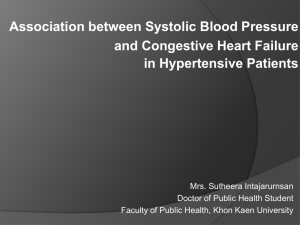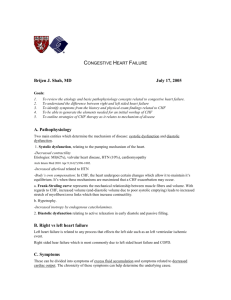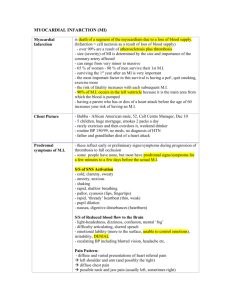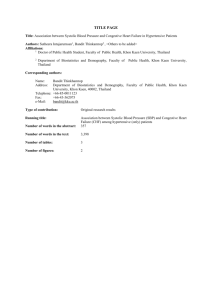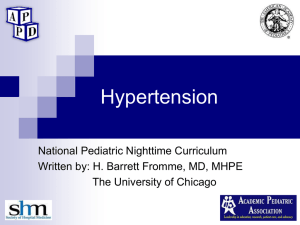Updated Association between SBP and CHF lastest for 1st DJC
advertisement
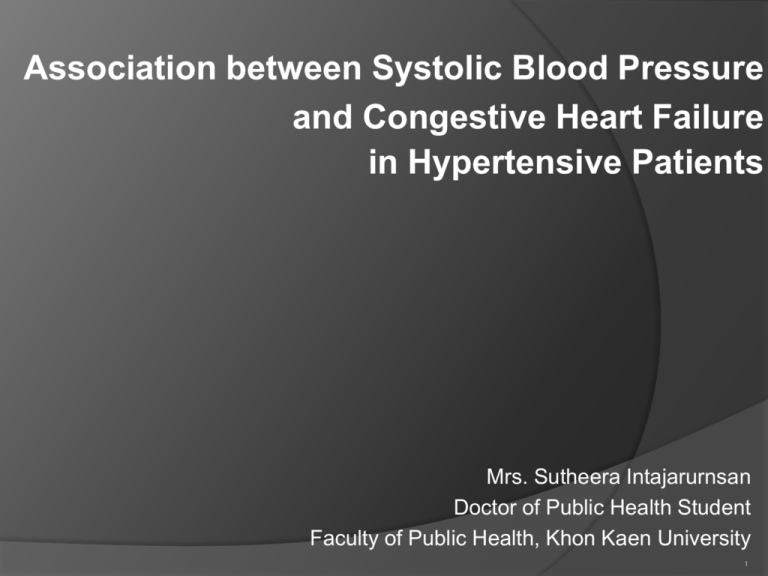
Association between Systolic Blood Pressure and Congestive Heart Failure in Hypertensive Patients Mrs. Sutheera Intajarurnsan Doctor of Public Health Student Faculty of Public Health, Khon Kaen University 1 Outlines Background Objectives Materials and Methods Results Discussions Conclusions 2 Background http://isp.swanih.org As many as 1 billion people worldwide suffer from hypertension which estimated to cause 4.5% of current global disease burden Of all the potential complications of hypertension, congestive heart failure (CHF) was the most consistently found, it is called “Silent disease” http://www medical device network.com 3 Background (cont.) http:// www. siamhealth.net Systolic blood pressure (SBP) is a major predictor of cardiovascular disease, one of complications in hypertensive (HT) patients Gaps of knowledge: There are some controversial findings regarding the association between SBP and risk of CHF. 4 Objectives To investigate the association between SBP and CHF among hypertensive patients in Thailand 5 Materials and Methods Study design Cross-sectional study Based on the survey of the An Assessment on Quality of Care among Patients Diagnosed with Type 2 Diabetes (DM) and Hypertension (HT) Visiting Hospitals of Ministry of Public Health and Bangkok Metropolitan Administration in Thailand, from 2010 to 2012 6 Materials and Methods (cont.2) Study outcome Association between SBP and CHF Independent variable SBP (polytomous categorical variables) Dependent variable CHF (dichotomous categorical variables) Covariate variables Gender, Age, Occupation, BMI, Smoking, Lipid profiles, and ECG results 7 Materials and Methods (cont. 3) Statistical analysis Descriptive analysis Bivariate analysis Multivariate analysis (Multiple logistic regression) All analyses were performed using Stata version 12.0 (Stata Corp, College Station, TX). A p-value of less than 0.05 was considered statistical significant. 8 Results Total sample of DMHT patients (n = 174,578) Exclude 24,266 of DM and 55,277 of DMHT Sample of HT (only) patients (n = 95,035) 56,236 Missing and 319 not report in medical records CHF assessment (n= 38,480) 9 Results ; Characteristics Gender Age 36.6 % 13 % Male 63.4 % < 50 yrs. ≥ 50 yrs. Female 87% n= 38,478 n= 38,429 7.20% 29.50% 44.60% 55.50% 63.30% n= 32,482 BMI Underweight Normal Overweight n= 37,285 Occupation Non-sedentary occupation Sedentary occupation Results ; Characteristics (cont. 2) 6.30% 19% 25.90% Optimal (< 120) Pre-hypertension (120-139) Hypertension I (140-159) 48.80% Hypertension II (≥ 160) (*Joint National Committee on Prevention, Detection, Evaluation, and Treatment of High Blood Pressure (JNC); 7th report, 2009.) n= 38,345 Systolic blood pressure* 13.9 % No Yes 86.1 % Smoking History n= 20,626 11 Results ; Factors associated with CHF complication in hypertensive patients (≥100 mmHg) (≥ 160 mmHg) (≥ 23 kg/m2 ) Fig. 2. Factors affecting CHF complication in hypertensive patients , presented as odds ratio adjusted for gender, age, occupation, BMI, SBP, DBP and smoking history, using multiple logistic regression 12 Discussions This findings There were no significant associations between SBP and CHF complication among hypertensive patients (p = 0.223, 95%CI across 1.0) However, hypertensive patients who had high systolic blood pressure levels, were likely to obtained occurring of CHF complication. 13 Discussions (cont. 2) Previous findings The Framingham Heart Study showed hypertension (SBP>140 mmHg) was associated with a two-fold increased risk of HF in men when compared with normal (SBP<140 mmHg) Answer the gap of knowledge; These results likely presented the positive association but not significant difference, which is not consistent with other studies. 14 Discussions (cont. 3) Strength Nationally representative sample Real situations Saving for time and budget Limitation Insufficient data and missing values in medical records (handle by using best case and worst case method compared with based case) Information bias from data recording by medical staffs 15 Conclusions Systolic blood pressure was not significantly associated with congestive heart failure in hypertensive patients. 16 Recommendations Interesting point that cloud be created for further study What is the cut off point for SBP level which predict the high risk of CHF? (especially in Asian) Should required lager sample size Design the study by using an RCT Benefits Studies regarding risk and protective factors lead to prevention of morbidity and mortality among HT patients. Therefore, further understanding of those factors that activate patients to CHF is essential to guide strategies for prevention. 17 Acknowledgements Collaborative partnerships of the Thailand National Health Security Office (NHSO) and the Thailand Medical Research Network (MedResNet). Prof. Dr. Bandit Thinkamrop Dr. Cameron Hurst Miss Wilaiphorn Thinkamrop My seniors; especially Dr.PH batch 4 All my classmates; Dr.PH batch 5 18 Thank You for Your Attention
